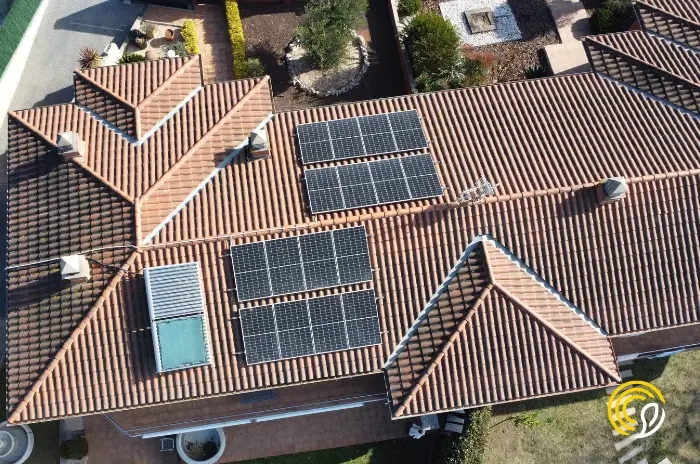
Solar shingles, we answer all your questions

Claudia Pardo, Content Specialist at Sunhero and a firm believer that solar energy can transform the world.
14/11/2024
3 min read
Table of Contents
Installing solar panels at home is an increasingly attractive option for those looking to reduce their carbon footprint and save on electricity bills. However, the design of traditional panels may not fit with the aesthetic of some homes, and this is where solar tiles stand out as an elegant and functional alternative.
In this article, we explain what solar tiles are, the types and models available, their performance, installation costs, and the best times to consider using them.
What are solar tiles?
Solar tiles are an alternative to conventional solar panels that allow electricity generation without compromising the roof’s design. These tiles integrate photovoltaic cells into materialssimilar to traditional tiles, such as ceramic or glass, offering the same durability and climate protection as a regular roof. Instead of placing panels on top of the roof, solar tiles replace existing tiles and blend seamlessly with the home’s architecture.
There is also the option of solar windows, which integrate photovoltaic cells into glass surfaces to maximize energy capture on large windows or facades.
Types of solar tiles and performance
There are various types of solar tiles on the market, each with unique characteristics that affect their performance:
- Monocrystalline Silicon Tiles: These offer higher performance due to their pure silicon structure, which allows them to capture direct sunlight more efficiently. They are a good option for sunny climates, although they tend to be more expensive.
- Polycrystalline Silicon Tiles: These are more affordable than monocrystalline tiles but have lower efficiency. They work well in diffuse light conditions, making them suitable for areas with less direct solar radiation.
- Thin-Film (CIGS) Tiles: These flexible tiles perform well in low-light or partially shaded conditions, although they don’t reach the same efficiency levels as silicon-based tiles.
In general, solar tiles tend to be less efficient than conventional solar panels, with an efficiency rate of 10%-15% compared to the 18%-22% efficiency of panels. However, their architectural integration is an attractive feature for homeowners looking for a discreet energy solution.
Installation costs of solar tiles
The cost of installing solar tiles is higher than that of conventional panels due to the complexity of their design and installation process. In Spain, the approximate cost is €325 per square meter, though it may vary depending on the manufacturer and the type of tile. For a complete installation, costs can be significantly higher compared to an equivalent power system using panels.
Despite the higher initial cost, solar tiles have the potential to add value to a property due to their aesthetic appeal and energy generation capability. Additionally, over the long term, savings on electricity bills can help offset the investment, although the payback period may be longer compared to traditional solar panels.
When is it advisable to install solar tiles?
Installing solar tiles is ideal during the construction of a new home or when renovating a complete roof. In these situations, integration costs can be optimized, and the home’s structure can easily adapt to solar tiles from the beginning. This reduces the need for additional modifications and ensures that the system operates at its full potential.
However, in existing homes, installing solar tiles can be more complex. Removing existing tiles and modifying the roof structure to integrate solar tiles involves higher costs and a longer installation process.
For this reason, it is essential to assess the technical and economic feasibility before proceeding with solar tiles in existing homes.

Advantages and disadvantages of Solar Tiles
Solar tiles offer a range of advantages and some drawbacks that should be considered before making a decision.
Advantages
- Aesthetic Appeal: Solar tiles integrate seamlessly with the roof, preserving the home’s appearance without compromising its design.
- Increased Property Value: Homes with integrated solar systems may enjoy a higher resale value.
- Durability: Designed to withstand extreme weather conditions, solar tiles are as resilient as traditional roofing tiles.
- Reduced Carbon Footprint: Like solar panels, solar tiles generate clean energy, helping to reduce carbon emissions.
Disadvantages
- High Cost: Installation is significantly more expensive than conventional panels, both in materials and installation.
- Lower Efficiency: Solar tiles generally have lower energy efficiency compared to conventional solar panels.
- Complex Installation for Existing Homes: Installation on existing roofs can be more complex and costly, as it may require removing current tiles.
- Limited Availability: Solar tiles are less common than panels, making it harder to find providers and specialists for this type of installation.
Does Sunhero install solar tiles on demand?
Sunhero specializes in the installation of self-consumption systems for both homes and companies, offering customized solutions tailored to each client’s specific needs.
Our team evaluates each project to recommend the best option based on available space, energy consumption, and the client’s goals, ensuring an efficient and long-lasting installation.
While solar tiles are an attractive alternative for some homeowners, at Sunhero we assess each case individually to determine if this option is suitable and to provide complete technical guidance. Additionally, we offer personalized quotes so that each client has a solar solution that maximizes their investment and energy savings.
Start today!
Fill out our free solar calculator and get a custom quotation































